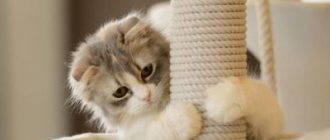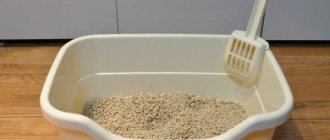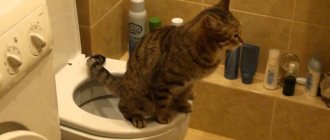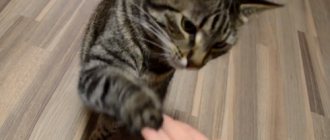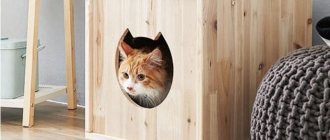Small kittens can be litter trained in a few days, but with an older animal it will take much longer. After all, your pet already has a habitual way of going to the toilet and it will not be easy for him to accept new rules. But this does not mean that you will have to put up with unpleasant odors in the house; with the correct organization of the process, even an adult cat can be trained to use the litter box.
Tray selection
The shape, size, height of the cat litter tray - all this matters. To accustom an adult cat to the litter box, you need to choose a container in which it will completely fit, because previously the animal has not experienced tightness of space when going to the toilet. Sharp corners that could injure the animal should be avoided, so regular thin plastic food containers will not work.
Choosing a litter tray is an individual process, and it is difficult to predict in advance which litter box will suit this particular cat. Sometimes you need to be patient and change several trays until you find one that is suitable and convenient.
If the task is to accustom an adult street cat to a litter box, you should pay attention to closed trays in the form of houses. After all, animals that are shy by nature may refuse to go to the toilet in an open container, and a completely closed house will become for them a quiet and secluded place, reminiscent of their previous habitat.
For cats that constantly spill litter outside the tray, it is recommended to purchase containers with mesh. Their secret is that cat litter is poured into a tray and a grate is placed on top. Even if the animal intensively paws in an attempt to bury its excrement, the litter does not spill onto the floor, and the room remains clean.
Cats are sensitive to odors, so to accustom an adult cat to a new litter box, you need to pour a small amount of previously used litter into it and bring it to the animal. After the instincts kick in, the cat recognizes its smell and begins to defecate into a new container.
Special pads for training a cat to use the toilet
To help their pets adapt to new conditions, some owners use a mesh tray insert. They cut holes along the edges and then tape it to the toilet seat. You can even pour a little filler there at first.
You can make your own plastic mesh cover from a cat potty
But there is no need to make anything; in pet stores you can find special toilet accessories for training cats. Structurally, they look different, but the principle of operation is the same for all. They are an ordinary plastic cat potty that gradually turns into an overlay.
A plastic toilet cover for training cats makes this process easier.
At the first stage, everything happens in the same way as described above, the tray is installed on top of the toilet. But there is no need to clean it up abruptly, because sometimes cats at this stage refuse to do their business correctly and begin to crap in other places.
A new hole is cut out in a special pad every few days.
A specialized pad in which a small hole is first cut out greatly facilitates the habituation process. About once every 5-6 days it is slightly enlarged (cut or broken, depending on the specific model). The cat understands that it is impossible to step into the middle and slowly adapts to the enlarging hole. At its maximum size, when the pet can confidently hold on to the toilet itself, the lining can be removed completely. Using such devices, you can train small cats and even kittens.
By gradually enlarging the hole in the pad, it is much easier to train your cat to use the toilet
There are reusable systems, they are designed a little differently. They include a set of plastic pads with holes of different sizes, which are changed as the animal gets used to it.
Reusable plastic pads are replaced as the cat gets used to the new conditions for relieving itself.
When purchasing pads, you must take into account the weight of your pet and the thickness of the plastic of the product. The heavier the cat, the more massive and thicker such a device should be.
Filler
Previously, it was customary to pour sand into cat litter boxes. Although it does not absorb odors, and a caustic plume appears in the house very quickly, for an animal that previously lived on the street, such a choice is completely justified for the first time.
As soon as the cat gets used to going to the tray with sand, you can gradually mix filler granules into it. Each time after cleaning, more and more filler is added to the container until it completely displaces the sand.
Popular fillers include:
- woody;
- mineral;
- silica gel.
Wood filler is biodegradable and is valued for its low cost. However, you need to take into account that it does not absorb odors well; you will need to completely change the contents of the tray every 1-2 days. In addition, wood filler pellets may contain hard wood chips that can injure your pet's paws.
It will not be possible to train an adult cat to go to a litter tray with litter that hurts its paws or sticks to its pads. Experiments with the selection of the optimal type of filler should be carried out until the owner and pet are completely satisfied with it.
The mineral filler turns into a solid lump when liquid is applied to it, which helps absorb unpleasant odors. The frequency of changing the tray depends on the selected mineral. When choosing a zeolite, it is sufficient to completely replace the contents of the tray once a week, and lumps must be removed with a special spatula as they appear daily. Cheap bentonite litter needs to be changed every 1-2 days.
If the inside of the container is dirty, it will not be possible to quickly accustom an adult cat to the tray. These are very clean animals that would rather be forced to look for a secluded place in the corners of the apartment than to get their paws dirty in a dirty tray.
Among the main disadvantages of mineral fillers are the lack of cleanliness in the house and the danger of swallowing granules. You can reduce the amount of scattered litter by purchasing a lattice tray or installing a special removable litter under the container, where the granules will be poured out after your pet goes to the toilet. Kittens chew and swallow litter more often; with adult cats, the risk is minimal, so this type of litter can be safely chosen to train a cat to use the litter box.
Silica gel filler absorbs odors better than others. It is environmentally friendly, safe, and prevents the growth of bacteria. This type of litter is a godsend for owners who don’t like to clean their pet’s litter tray often. Silica gel litter is suitable for litter training, for example, an adult Bengal cat, which is known for its increased demands on the cleanliness of the toilet. The only negative is the high cost.
How to litter train an adult cat?
Accustoming an adult animal with established habits to the litter box should be done calmly and non-violently, without unnecessary fuss.
1. For the first time, lock your pet in the same room as the toilet, blocking his access to secluded corners.
2. Make sure that there are no other sources of cat odor in the room that could attract the animal.
3. Place a small amount of feces in the tray or lightly blot the urine with a piece of paper so that the cat recognizes its smell and quickly gets used to the tray.
4. If the cat is restless, fidgeting, or raking his paws outside the tray, take him to the tray, talking to him gently.
5. Don't forget to praise your pet every time he relieves himself in the litter box.
6. Don’t worry, 3-4 misses before the cat masters the litter box is completely normal. Treat the area with peroxide, vinegar, perfume, or cat urine odor spray to prevent a recurrence.
7. Do not punish the guilty cat; express your dissatisfaction exclusively with intonation, without shouting or threats.
Right place
It is important not only to purchase a good tray and litter, but also to choose a place in the house that will not cause embarrassment to the animal. It is better if it is a toilet or bathroom, i.e. rooms with low traffic. Cats do not like it when strangers observe such an important process, so it is better to leave them alone with the door slightly open.
If for some reason the cat went to the toilet on the carpet or in the corner of the house, you need to blot the puddle with litter granules and take them to the tray. It would also be a good idea to temporarily place the tray where the pet has chosen. It will be easier for the animal to first get used to the tray, and then to the new place.
How to stop a cat from marking
In nature, cats adhere to a hierarchical system of behavior. Marks can only be left by cats that are leaders, or those that claim this place. Therefore, in a home environment, a cat must have its own leader, whom he will respect. But it is impossible to achieve this by poking the cat’s muzzle into your secretions and hitting him with slippers. The problem needs to be solved differently.
You may find this funny and amusing, but you will have to arrange something like a cat fight. Cats do not understand human speech, so the best solution is to act in their language of sounds and gestures. When the cat raises its tail to mark something, go up to it and grab it by the scruff of the neck. When he calms down and presses his paws, it will be possible to proceed directly to the battle of characters.
First you need to hiss at the cat. Also, throughout the entire process, try not to look away; if you break eye contact, the cat will consider that he has won. Without any effort, using light blows of your fingers, hit the cat on the face, this will simulate blows with your paws.
With all this, you need to be really angry with your cat, since they sense the emotional state of a person quite well. Otherwise, he will not take this fight seriously.
If everything is done correctly, the cat will stop resisting. When the cat starts to turn away and meow, it can be considered that the job is done. All that remains is to wash away all traces; in order to leave your scent, spray your perfume or cologne on the marks. A new leader will appear in the house and you can forget about the unpleasant smell and aggressive behavior of the cat.
In general, as practice shows, cats are animals with a pronounced personality. And in all cases an individual approach to them is needed.
A lot of patience
Cats are sensitive to human emotions. In case of failures with litter box training, you need to try to find and eliminate the cause before taking out your irritation on the animal. Cats mark corners not to spite the owner, but because something confuses them in the place designated for the toilet. Take a closer look at your pet; perhaps he is uncomfortable in the new tray, the filler is too large and scratches his paws, or has an unpleasant aroma for the pet.
By eliminating negative factors and arranging comfortable conditions for the pet, the owner will be able to ensure that the animal visits the litter box without mistakes and get an affectionate, contented and purring friend.
Do we teach how to go “on business” outside in a private house?
The most comfortable living conditions for any cat is a private home. Here the problem with the toilet can be solved quickly - just let the animal out into the yard (if you also build an outdoor house, then there will be no problems at all). To do this, you can make a special exit at the bottom of the door or come up with other designs so as not to constantly open the front door.
First of all, the size and height of the sides are selected depending on the physiological characteristics of the kitten.
Some owners buy and install two different types of trays to determine which one is more suitable. In addition, the use of two trays simplifies cleaning and replacing the filler.
Useful tips
- When you bring a new animal into the house, close all hard-to-reach corners - the space under the bathroom, under the bed, in the corner behind the chair. This is where cats most often hide in an attempt to find privacy.
- Observe your pet's behavior. Restlessness, thrashing, and confusion may be signs that your cat is looking for a place to go to the toilet.
- If your cat persistently goes to the toilet in the wrong place, use sprays with a repellent odor.
- Never wash the tray with bleach or scented household chemicals.
- The most important thing is to praise your pet for every successful visit to the toilet, because it is so important for him to receive your approval.
By showing attentiveness, care and patience towards your pet, you can accustom the animal to the tray in just a week. Clean the cat litter box in a timely manner, limit access to the litter box for other animals, and then the chances of success will be close to 100%.
Necessary purchases
Before you bring a cat into your home, you should take care of purchasing important things that will help set up his litter box. Among them are:
- special tray;
- filler.
You can train a cat to go to the right place only with the right choice of necessary accessories. There are two types of animal trays: open and closed. A standard, ordinary tray with sides is the best option for a furry pet. This design is very convenient to use. Most often purchased products are made of plastic. There are also trays equipped with a grid. This option is more suitable if there is no filler.
If the cat wants to bury his works, then you can take a closer look at products with high sides.
© shutterstock
A closed tray is a special structure, isolated from surroundings, with a hole or door. Such houses for cats are usually equipped with a system for filtering and purifying odor . Closed trays can be useful for those owners who do not have a lot of free time to regularly clean the cat's litter box. But to clean such a structure, it will need to be disassembled. The main disadvantage of closed tray models is the high cost.
When choosing a tray for your pet, you should also take into account the age of the animal. A small kitten will need a design with low sides. And as the cat grows, the toilet changes to a larger tray.
To quickly teach your cat to go to the litter box, you can buy a special litter. An empty tray is not hygienic, and many animals refuse to go to a structure with a grid. In pet stores you can find a large selection of pet litters that differ in their structure and composition.
Types of materials:
- sawdust, compressed in a certain way: environmentally friendly and safe material that does not cause allergies in cats, and is suitable for animals of all ages (material replacement is required every 4-5 days);
- mineral filler: has high adsorption, preventing the spread of odors (less economical option: in a tray the layer thickness should not be less than 5 cm);
- silica gel-based litter: a material with a high ability to absorb odors, easy to use (the most expensive type of litter, and in order for the cat to find the toilet on time, replacement is required no more than every 3-4 weeks);
- material from industrial waste and corn: inexpensive and safe filler, suitable for both adult pets and small kittens.
Toilet training an animal will be quicker and easier if cleaning is done on time. The materials used must not contain harmful impurities and additives or emit foreign odors. For one cat in the house, options that form clumps are more suitable. But if several cats live in a home at once, then it is better to buy materials with high absorbency.
For small pets, it is recommended to use safe and simple wood filler or products made from industrial waste.
© shutterstock
Does the age of the kitten matter?
To understand how to quickly train a small kitten to use a litter tray, you need to take into account its age characteristics.
It is necessary to engage in training from the first day a cat appears in the house, even if it is very tiny. Kittens perceive information and form conditioned reflexes from the first to the third months of life. Accordingly, if you forgive “unconscious” mistakes during this period, it will be much more difficult to change the child’s habits and worldview later.
The easiest time to train a kitten to use a litter tray is under three months of age. After three months, it is difficult to wean a kitten from mistakes, especially if he lived on the street. After four months and into adulthood, the animal will have great difficulty mastering going to the litter box - owners need to be patient and take into account all the cat’s wishes.
Basic rules for cats and kittens
Most experts say that it is much easier to toilet train an animal at an early age . And this statement is absolutely true. If the kitten spent the first months of its life next to its mother, then it is most likely already familiar with the main nuances of the process. And when moving to a new home, it will be much easier to train the animal. In this case, you just need to show the new toilet to the kitten, and for some time monitor the correct choice of place.
If the small cat has not yet been familiar with the litter box, then the owners will have to resort to some tricks to potty train him.
- As soon as the new owner crosses the threshold of the home for the first time with an animal in his arms, he should immediately show the tray. It is advisable to leave your pet there alone for a while so that he gets to know the territory and sniffs it.
- The sources of all foreign odors in the apartment and near the toilet should be eliminated. At first, it will be quite difficult for the animal to navigate uncharted territory, and strong aromas can frighten and confuse your furry pet.
- Almost all animals can experience stress from moving to a new home. It is recommended to be close to your cat and help in difficult situations. At the first sign of need, your pet should be taken to the bathroom. Then the animal will immediately understand what the owner wants from him, and it will not be difficult to accustom him to the procedure.
- If the cat is uncomfortable in his litter box, the dimensions are not appropriate for his age, or the filler is not suitable, then you will have to buy new devices. It may also be necessary to change the location of the tray if the pet is not comfortable in the old place. The animal should feel confident and safe.
